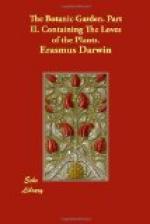On
silvery beds, of soft asbestus wove,
Meets
her Gnome-husband, and avows her love.
395 —High o’er her couch
impending diamonds blaze,
And
branching gold the crystal roof inlays;
With
verdant light the modest emeralds glow,
Blue
sapphires glare, and rubies blush, below;
Light
piers of lazuli the dome surround,
400 And pictured mochoes tesselate the ground;
In
glittering threads along reflective walls
The
warm rill murmuring twinkles, as it falls;
Now
sink the Eolian strings, and now they swell,
And
Echoes woo in every vaulted cell;
405 While on white wings delighted Cupids play,
Shake
their bright lamps, and shed celestial day.
Closed
in an azure fig by fairy spells,
Bosom’d
in down, fair CAPRI-FICA dwells;—
[Caprificus. l. 408 Wild fig. The fruit of the fig is not a seed-vessel, but a receptacle inclosing the flower within it. As these trees bear some male and others female flowers, immured on all sides by the fruit, the manner of their fecundation was very unintelligible, till Tournefort and Pontedera discovered, that a kind of gnat produced in the male figs carried the fecundating dust on its wings, (Cynips Psenes Syst. Nat. 919.), and, penetrating the female fig, thus impregnated the flowers; for the evidence of this wonderful fact, see the word Caprification, in Milne’s Botanical Dictionary. The figs of this country are all female, and their seeds not prolific; and therefore they can only be propagated by layers and suckers.
Monsieur de la Hire has shewn in the Memoir, de l’Academ. de Science, that the summer figs of Paris, in Provence, Italy, and Malta, have all perfect stamina, and ripen not only their fruits, but their seed; from which seed other fig-trees are raised; but that the stamina of the autumnal figs are abortive, perhaps owing to the want of due warmth. Mr. Milne, in his Botanical Dictionary (art. Caprification), says, that the cultivated fig-trees have a few male flowers placed above the female within the same covering or receptacle; which in warmer climates perform their proper office, but in colder ones become abortive: And Linneus observes, that some figs have the navel of the receptacle open; which was one reason that induced him to remove this plant from the class Clandestine Marriage to the class Polygamy. Lin. Spec. Plant.
From all these circumstances I should conjecture, that those female fig-flowers, which are closed on all sides in the fruit or receptacle without any male ones, are monsters, which have been propagated for their fruit, like barberries, and grapes without seeds in them; and that the Caprification is either an ancient process of imaginary use, and blindly followed in some countries, or that it may contribute to ripen the fig by decreasing its vigour, like cutting off




